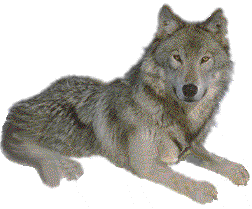Information On Wolves


The Wolf
Carnivore related to the jackal and domestic dog. All wolves are characterized by powerful
teeth, bushy tails, and round pupils. Certain characteristics of the skull distinguish them from
domestic dogs, some breeds of which they otherwise resemble.
Two species of wolves are recognized: the gray, or timber, wolf, once widely distributed in North
America, Europe, and Asia; and the red wolf, which now occurs only in Texas and the
southeastern United States. An adult gray wolf measures up to 1.6 m (6.5 ft) in length,
including the tail (which is less than half the body length), and may weigh up to 80 kg (175 lb).
The animal is red-yellow or yellow-gray, with black patches above and white below; black or
brown timber wolves also occur, and those in the far north may be pure white. The red wolf is
somewhat smaller in size and usually darker in color.
Wolves are equally at home on prairies, in forestlands, and on all but the highest mountains. In
the winter they travel in packs in search of food. Small animals and birds are the common prey
of wolves, but a pack may sometimes attack reindeer, sheep, and other large mammals,
usually selecting weak, old, or very young animals for easier capture. When no live prey can be
found, wolves feed on carrion. They also eat berries.
The den, or lair, of the wolf may be a cave, a hollow tree trunk, a thicket, or a hole in the ground
dug by the wolf. In the spring, females have litters of one to eleven pups. Adult wolves
sometimes feed young pups by regurgitating partly digested food for them. The pups normally
stay with the parents until the following winter but may remain much longer. Parents and young
constitute a basic pack, which establishes and defends a territory marked by urine and feces.
Larger packs may also assemble, particularly in the winter; the pack leader is called the alpha
male, and his mate is the alpha female. As social animals, wolves exhibit behavioral patterns
that clearly communicate dominance over or submission to one another. The communal
howling of a pack may serve to assemble its members, communicate with other packs, or
advertise its territorial claims, or it may be simply a source of pleasure. Visual and scent signals
are also important in communication.
Although wolves are still abundant in eastern Europe and in Asia, only remnant populations
now exist in western Europe, and their numbers in the Americas also have been greatly
diminished. They are fairly abundant in Alaska and Canada, but significant remnant
populations of wolves south of Canada occur only in Minnesota and Mexico; smaller numbers
exist in several western and midwestern states. Under the Endangered Species Act, the gray
wolf is listed as a threatened species in Minnesota and as an endangered species elsewhere in
the United States outside of Alaska. The decreasing numbers of wolves are the result of
encroachments on their territory by humans, who have long regarded wolves as competitors for
prey and as dangerous to livestock, pets, and people. However, few, if any, healthy wolves have
attacked humans, whom they instead try to avoid. Wolves are valuable predators in the food
web, and their decimation has led to the overpopulation of certain other animal species in
various areas. There are active efforts to reintroduce wolves to national parks in the United
States, although such efforts are controversial. Coyotes have hybridized with some red wolves.
An attempt to reintroduce red wolves to parts of North Carolina has involved identifying red
wolves that were not part coyote; the success of this project is not yet clear. In 1995 and 1996,
the United States Fish and Wildlife Service reintroduced Canadian gray wolves into
Yellowstone National Park despite protest from ranchers and some biologists. The reintroduced
wolves are producing more offspring than expected. When ten breeding pairs reside in the
region for three years, the gray wolf will be taken off the list of endangered species in the
northern Rocky Mountains. Wolf biologists estimate that this goal may be met by the year 2002
without the transplanting of additional wolves from Canada.
Scientific classification: The wolf belongs to the family Canidae. The gray, or timber, wolf is
classified as Canis lupus. The red wolf is classified as Canis rufus.
Gray Wolf
The gray wolf is one of approximately 38 species belonging to the family Canidae, which includes the coyote, jackal, fox, and dog. This family is believed to have originated in North America 54 to 40 million years ago during the Eocene epoch. The gray wolf, also called the timber wolf or white wolf, is distributed across northern North America and Eurasia. It is found in a variety of habitats including mountains, plains, deserts, forests, tundra, and taiga.
Wolves
There were once at least thirty different subspecies of wolf. Most have become extinct. About five subspecies survive today. In England, the last wolves were wiped out by about 1500, a few still live in eastern Europe, India, Germany, Italy, Spain and the Middle East. No one knows how many survive in Russia and China. Most wolves in North America are found in Alaska and Canada and hunters, from whom most of our knowledge of this shy creature comes from, say they are now almost impossible to find....
Aimys Awesome Information
Information On The Lakota Sioux
Pictures Of The Lakota Sioux
Information On The Sign: Aquarius
Pictures Of Wolves
Winnie The Pooh Stuff
ANGELS
My Poems
My Dads Race Car


Email: aimy_tracker_chick@yahoo.com


